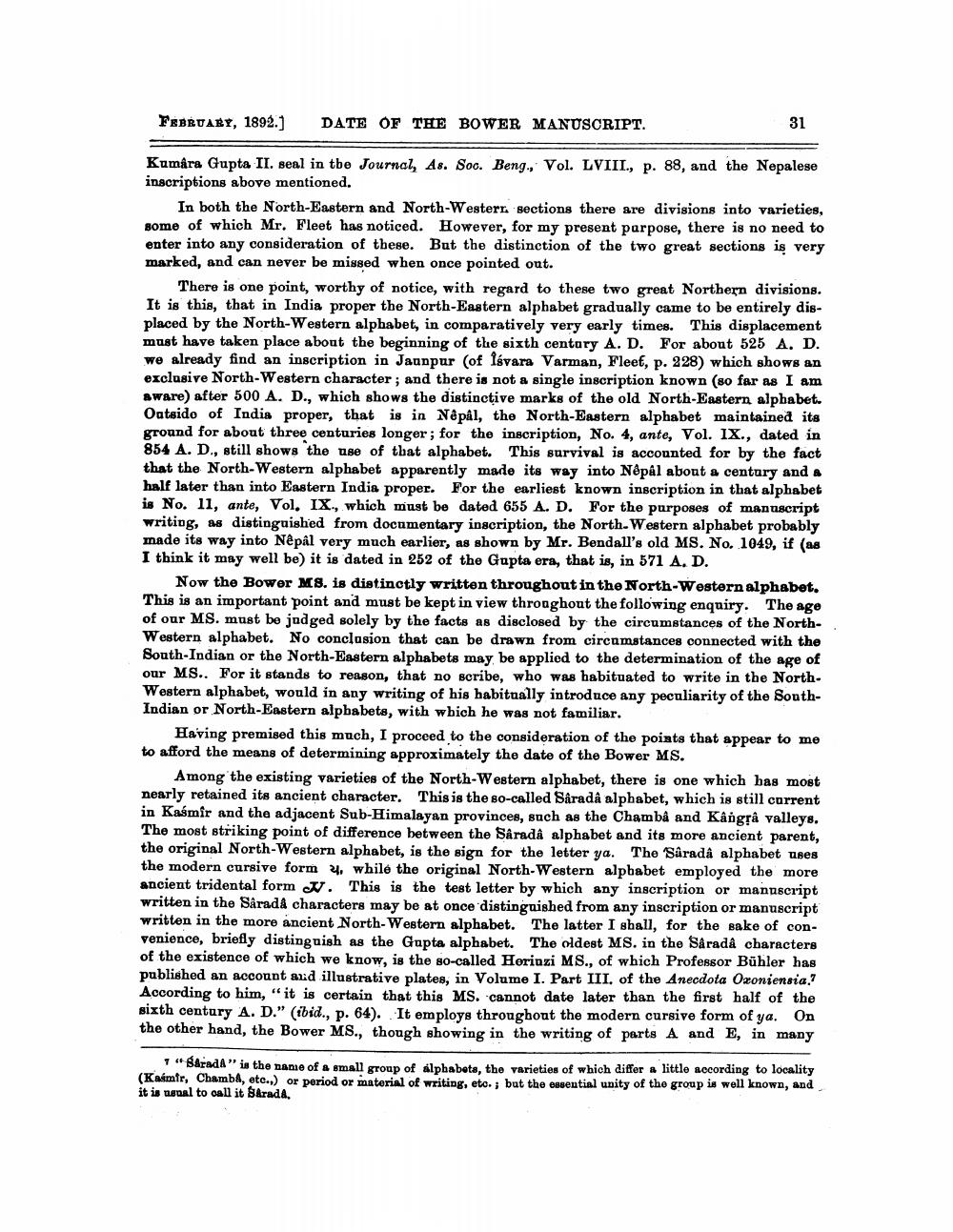________________
FEBRUARY, 1892.)
DATE OF THE BOWER MANUSCRIPT.
31
Kumara Gupta II. seal in tbe Journal, As. Soc. Beng, Vol. LVIII, p. 88, and the Nepalese inscriptions above mentioned.
In both the North-Eastern and North-Westerr. sections there are divisions into varieties, some of which Mr. Fleet has noticed. However, for my present parpose, there is no need to enter into any consideration of these. But the distinction of the two great sections is very marked, and can never be missed when once pointed out.
There is one point, worthy of notice, with regard to these two great Northern divisions. It is this, that in India proper the North-Eastern alphabet gradually came to be entirely displaced by the North-Western alphabet, in comparatively very early times. This displacement must have taken place about the beginning of the sixth century A. D. For about 525 A. D. we already find an inscription in Jaunpur (of lśvara Varman, Fleef, p. 228) which shows an exclusive North-Western character, and there is not a single inscription known (so far as I am aware) after 500 A. D., which shows the distinctive marks of the old North-Eastern alphabet. Oatsido of India proper, that is in Nepal, the North-Eastern alphabet maintained its ground for about three centuries longer; for the inscription, No. 4, ante, Vol. IX., dated in 854 A. D., still shows the use of that alphabet. This survival is accounted for by the fact that the North-Western alphabet apparently made its way into Nepál about a century and a half later than into Eastern India proper. For the earliest known inscription in that alphabet is No. 11, ante, Vol. IX., which must be dated 655 A. D. For the purposes of manuscript writing, as distinguished from documentary inscription, the NorthWestern alphabet probably made its way into Nepál very much earlier, as shown by Mr. Bendall's old MS. No. 1049, if (as I think it may well be) it is dated in 252 of the Gupta era, that is, in 571 A. D.
Now the Bower MS. is distinctly written throughout in the North-Western alphabet. This is an important point and must be kept in view throughout the following enquiry. The age of our MS. must be judged solely by the facts as disclosed by the circumstances of the NorthWestern alphabet. No conclusion that can be drawn from circumstances connected with the South-Indian or the North-Eastern alphabets may be applied to the determination of the age of our MS.. For it stands to reason, that no scribe, who was habituated to write in the NorthWestern alphabet, would in any writing of his habitually introduce any peculiarity of the SouthIndian or North-Eastern alphabets, with which he was not familiar.
Having premised this much, I proceed to the consideration of the points that appear to me to afford the means of determining approximately the date of the Bower MS.
Among the existing varieties of the North-Western alphabet, there is one which has most nearly retained its ancient character. This is the so-called Saradâ alphabet, which is still current in Kasmir and the adjacent Sub-Himalayan provinces, such as the Chambâ and Kangrå valleys. The most striking point of difference between the Sâradâ alphabet and its more ancient parent, the original North-Western alphabet, is the sign for the letter ya. The Såradâ alphabet uses the modern cursive form 2. while the original North-Western alphabet employed the more ancient tridental form N. This is the test letter by which any inscription or manuscript written in the Sarad& characters may be at once distinguished from any inscription or manuscript written in the more ancient North-Western alphabet. The latter I shall, for the sake of convenience, briefly distinguish as the Gupta alphabet. The oldest MS. in the Så radâ characters of the existence of which we know, is the so-called Horinzi MS., of which Professor Bühler has published an account and illustrative plates, in Volume I. Part III. of the Anecdota Oxoniensia.? According to him," it is certain that this MS. cannot date later than the first half of the sixth century A. D." (ibid., p. 64). It employs throughout the modern cursive form of ya. On the other hand, the Bower MS., though showing in the writing of parts A and E, in many
1 "BaradA" is the name of a small group of alphabets, the varieties of which differ a little according to locality (Kaimir, ChambA, etc.) or period or material of writing, etc. ; but the onsential unity of the group is well known, and it is usual to call it Sarada.




